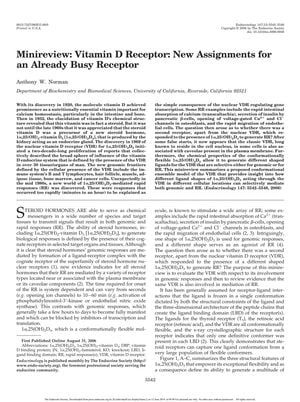Vitamin D Receptor: New Assignments for an Already Busy Receptor
December 2006
in “Endocrinology”

TLDR The vitamin D receptor is involved in multiple body functions beyond calcium regulation, including immune response and rapid reactions not related to gene activity.
In 1920, vitamin D was recognized as essential for calcium homeostasis, and by 1932 its chemical structure was identified as a steroid. It was later discovered that vitamin D is a precursor to the hormone 1alpha,25(OH)2-vitamin D3 [1alpha,25(OH)2D3], which is produced by the kidneys. The nuclear vitamin D receptor (VDR) for this hormone was found in 1969, and subsequent research over two decades revealed that the VDR is present in over 30 human tissues and organs, including the immune system, hair follicles, and cancer cells. In the mid-1980s, rapid responses (RR) to 1alpha,25(OH)2D3 were discovered, which occur too quickly to be explained by gene transcription regulation by the nuclear VDR. This led to the hypothesis of a second receptor, but it was later understood that the classic VDR is also associated with caveolae in the plasma membrane. The VDR can mediate both genomic and rapid responses due to the ability of 1alpha,25(OH)2D3 to form different shaped ligands that selectively interact with the VDR in various cellular locations. This minireview proposes a conformational ensemble model of the VDR that explains how different ligand shapes of 1alpha,25(OH)2D3 can selectively mediate both genomic and rapid responses through the VDR.
View this study on academic.oup.com →